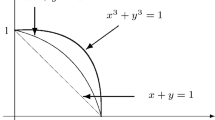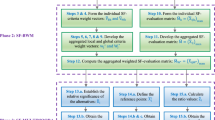Abstract
The present study focuses on the development of a novel distance measure for q-rung orthopair fuzzy sets in cognitive decision-making problems. The q-rung orthopair fuzzy set is an extension of the intuitionistic fuzzy set that allows for precise manipulation of ambiguous environments. By combining the concept of distance measure with q-rung orthopair fuzzy sets, the study aims to address the shortcomings of previous distance measures and provide a more accurate evaluation of q-rung orthopair fuzzy inherent information. The new distance measure is designed to calculate the differences between different pairs of q-rung orthopair fuzzy sets. The study illustrates the advantages of the proposed distance measure through meticulous numerical examples and examines its general axioms. The comparative study reveals that many established distance measures yield identical values for different pairs of q-rung orthopair fuzzy sets, which makes them unsuitable for accurately representing q-rung orthopair fuzzy inherent information. Additionally, the study introduces a new algorithm for solving fuzzy transportation problem using the proposed distance measure. A numerical example is discussed to validate the feasibility and applicability of the algorithm in real-life scenarios. The significance of the proposed method is evaluated through a comparative study, degree of hesitancy analysis, statistical tests, result analysis, and computational complexity assessment. The study thoroughly discusses these aspects to demonstrate the effectiveness of the proposed method. Finally, the study concludes by summarizing the findings and discussing future research directions for further improvement in the field of fuzzy transportation problem. Overall, the present study contributes to the field of cognitive decision-making by introducing a novel distance measure for q-rung orthopair fuzzy sets and demonstrating its advantages through various analyses and examples.





Similar content being viewed by others
Data availability
Not applicable.
References
Zadeh LA (1985) Fuzzy sets. Inf Control 8(3):338–353
Atanassov KT, Atanassov KT (1999) Intuitionistic fuzzy sets
Yager RR (2013) Pythagorean fuzzy subsets. In: 2013 joint IFSA world congress and NAFIPS annual meeting (IFSA/NAFIPS), pp 57–61
Yager RR (2016) Generalized orthopair fuzzy sets. IEEE Trans Fuzzy Syst 25(5):1222–1230
Suman S, Jasrotia R, Singh SP (2023) A mcdm-based framework for selection of photovoltaic cell technology using novel information measure under pythagorean fuzzy environment. Int J Inf Technol 15(8):4233–4242
Malik SC, Raj M, Thakur R (2023) Weighted correlation coefficient measure for intuitionistic fuzzy set based on cosine entropy measure. Int J Inf Technol 15(7):3449–3461
Ohlan A (2022) Multiple attribute decision-making based on distance measure under pythagorean fuzzy environment. Int J Inf Technol 14(4):2205–2217
Raj M, Tiwari P, Gupta P (2022) Cosine similarity, distance and entropy measures for fuzzy soft matrices. Int J Inf Technol 14(4):2219–2230
Kharya S, Soni S, Swarnkar T (2023) Fuzzy weighted Bayesian belief network: a medical knowledge-driven Bayesian model using fuzzy weighted rules. Int J Inf Technol 15(2):1117–1125
Nagoor S, Jinny SV (2023) A dual fuzzy with hybrid deep learning architecture based on cnn with hybrid metaheuristic algorithm for effective segmentation and classification. Int J Inf Technol 15(1):531–543
Jeyalakshmi K, Chitra L, Veeramalai G, Prabha SK, Sangeetha S (2021) Pythagorean fuzzy transportation problem via Monalisha technique. Ann Rom Soc Cell Biol 2078–2086
Kosheleva O, Kreinovich V (2018) Why Bellman–Zadeh approach to fuzzy optimization
Lin CJ, Wen UP (2004) A labeling algorithm for the fuzzy assignment problem. Fuzzy Sets Syst 142(3):373–391
Okada S, Gen M (1994) Fuzzy shortest path problem. Comput Ind Eng 27(1–4):465–468
Vidhya V, Ganesan K (2019) Solution of fully fuzzy transshipment problem through a new method. AIP Conf Proc 2112:020057
Majidi S, Hosseini-Motlagh SM, Yaghoubi S, Jokar A (2017) Fuzzy green vehicle routing problem with simultaneous pickup-delivery and time windows. RAIRO-Oper Res 51(4):1151–1176
Basirzadeh H (2011) An approach for solving fuzzy transportation problem. Appl Math Sci 5(32):1549–1566
Hussain RJ, Kumar PS (2012) Algorithmic approach for solving intuitionistic fuzzy transportation problem. Appl Math Sci 6(80):3981–3989
Kumar PS, Hussain RJ (2015) A method for solving unbalanced intuitionistic fuzzy transportation problems. Notes Intuit Fuzzy Sets 21(3):54–65
Saikia B, Dutta P, Talukdar P (2023) An advanced similarity measure for pythagorean fuzzy sets and its applications in transportation problem. Artif Intell Rev 56(11):12689–724
Prabha SK (2021) Geometric mean with pythagorean fuzzy transportation problem. Turk J Comput Math Educ (TURCOMAT) 12(7):1171–1176
Du WS (2018) Minkowski-type distance measures for generalized orthopair fuzzy sets. Int J Intell Syst 33(4):802–817
Peng X, Dai J (2019) Research on the assessment of classroom teaching quality with q-rung orthopair fuzzy information based on multiparametric similarity measure and combinative distance-based assessment. Int J Intell Syst 34(7):1588–1630
Peng X, Liu L (2019) Information measures for q-rung orthopair fuzzy sets. Int J Intell Syst 34(8):1795–1834
Liu P, Ali Z, Mahmood T (2021) Some cosine similarity measures and distance measures between complex q-rung orthopair fuzzy sets and their applications. Int J Comput Intell Syst 14(1):1653–1671
Pinar A, Boran FE (2020) A q-rung orthopair fuzzy multi-criteria group decision making method for supplier selection based on a novel distance measure. Int J Mach Learn Cybern 14(1):1749–1780
Liu P, Ali Z, Mahmood T (2021) Some cosine similarity measures and distance measures between complex q-rung orthopair fuzzy sets and their applications. Int J Comput Intell Syst 14(1):1653–1671
Zeng S, Hu Y, Xie X (2021) Q-rung orthopair fuzzy weighted induced logarithmic distance measures and their application in multiple attribute decision making. Eng Appl Artif Intell 100:104–167
Chanas S, Kolodziejczyk W, Machaj A (1984) A fuzzy approach to the transportation problem. Fuzzy Sets Syst 13(3):211–221
Chanas S, Kuchta D (1996) A concept of the optimal solution of the transportation problem with fuzzy cost coefficients. Fuzzy Sets Syst 82(3):299–305
Tada M, Ishii H (1996) An integer fuzzy transportation problem. Comput Math Appl 31(9):71–87
Liu ST, Kao C (2004) Solving fuzzy transportation problems based on extension principle. Eur J Oper Res 153(3):661–674
Gani AN, Razak KA (2006) Two stage fuzzy transportation problem
Gupta P, Mehlawat MK (2007) An algorithm for a fuzzy transportation problem to select a new type of coal for a steel manufacturing unit. TOP 15:114–137
Li L, Huang Z, Da Q, Hu J (2008) A new method based on goal programming for solving transportation problem with fuzzy cost. IEEE, pp 3–1
Lin FT (2009) Solving the transportation problem with fuzzy coefficients using genetic algorithms. IEEE, pp 1468–1473
Pandian P, Natarajan G (2010) A new algorithm for finding a fuzzy optimal solution for fuzzy transportation problems. Appl Math Sci 4(2):79–90
Guzel N (2010) Fuzzy transportation problem with the fuzzy amounts and the fuzzy costs. World Appl Sci J 8(5):543–549
Gani AN (2011) Simplex type algorithm for solving fuzzy transportation problem. Tamsui Oxf J Inf Math Sci 27(1):89–98
Kumar A, Kaur A (2011) Application of classical transportation methods to find the fuzzy optimal solution of fuzzy transportation problems. Fuzzy Inf Eng 3(1):81–99
Kumar MSB (2012) On fuzzy transportation problem using triangular fuzzy numbers with the modified, revised simplex method. Int J Eng Sci Technol 4(1):285–294
Pramila K, Uthra G (2014) Optimal solution of an intuitionistic fuzzy transportation problem. Ann Pure Appl Math 8(2):67–73
Ebrahimnejad A (2014) A simplified new approach for solving fuzzy transportation problems with generalized trapezoidal fuzzy numbers. Appl Soft Comput 19:171176
Das A-BRKAHUUK (2014) Logical development of vogel’s approximation method (ld-vam): an approach to find basic feasible solution of transportation problem. Int J Sci Technol Res (IJSTR) 3(2):42–48
Kumar R, Edalatpanah SA, Jha S, Singh R (2012) A pythagorean fuzzy approach to the transportation problem. Complex Intell Syst 5(2):255–263
Mitlif RJ, Rasheed M, Shihab S (2020) An optimal algorithm for a fuzzy transportation problem. J Southwest Jiaotong Univ 55(3)
Traneva V, Tranev S (2020) Intuitionistic fuzzy transportation problem by zero point method. In: 2020 15th conference on computer science and information systems (FedCSIS), vol 21. IEEE, pp 349–358
Mahajan S, Gupta SK (2021) On fully intuitionistic fuzzy multiobjective transportation problems using different membership functions. Ann Oper Res 296:211–241
Sahoo L (2021) A new score function based fermatean fuzzy transportation problem. Results Control Optim 4:100040
Bharathi SD, Kanmani G (2022) Solving pythagorean transportation problem using arithmeticc mean and harmoni mean. Int J Mech Eng 7
Hemalatha K, Venkateswarlu B (2023) Pythagorean fuzzy transportation problem: new way of ranking for pythagorean fuzzy sets and mean square approach. Heliyon 9(10)
Zhang Q, Hu J, Feng J, Liu A, Li Y (2019) New similarity measures of pythagorean fuzzy sets and their applications. IEEE Access 7:138192–138202
Peng X (2019) New similarity measure and distance measure for pythagorean fuzzy set. Complex Intell Syst 5:1101–111
Author information
Authors and Affiliations
Corresponding author
Ethics declarations
Conflict of interest
The authors declar that there is no conflict of interest.Acknowledgment: The authors greatly acknowledge the support of the DST-PURSE Programme SR/ PURSE/2022/143(1).
Rights and permissions
Springer Nature or its licensor (e.g. a society or other partner) holds exclusive rights to this article under a publishing agreement with the author(s) or other rightsholder(s); author self-archiving of the accepted manuscript version of this article is solely governed by the terms of such publishing agreement and applicable law.
About this article
Cite this article
Dutta, P., Saikia, B. & Banik, A.K. Novel distance measure for q-rung orthopair fuzzy sets with application to transportation problem. Int. j. inf. tecnol. (2024). https://doi.org/10.1007/s41870-024-01825-x
Received:
Accepted:
Published:
DOI: https://doi.org/10.1007/s41870-024-01825-x




